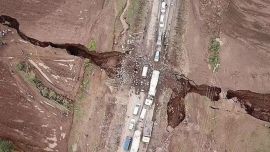As in many corners of the world, Latin America’s oceans, ice and glaciers are experiencing profound changes because of global warming, hitting the region’s communities and its biodiversity.
And the effects could worsen if greenhouse gas emissions keep growing, a new Intergovernmental Panel on Climate Change (IPCC) oceans report has cautioned.
The IPCC, which brings together climate scientists worldwide, has warned of potentially irreversible changes to the oceans and the cryosphere, portions of Earth’s surface where water is in solid form.
Sea-level rise could hit one metre by 2100 if the planet heats by 3C, the current trajectory based on global government policies. By the end of this century, the frequency of marine heatwaves could increase 50-fold compared with the end of the 19th century, the IPCC said.
“The open sea, the Arctic, the Antarctic, and the high mountains may seem far away to many people,” said Hoesung Lee, Chair of the IPCC. “But we depend on them and are influenced by them directly and indirectly in many ways.”
A total of 670 million people in high mountain regions and 680 million people in low-lying coastal zones worldwide rely on oceans and cryosphere ecosystems.
Drawing from 7,000 papers by over 100 leading climate scientists, the IPCC oceans report follows a special report on land use published last month.
“The impacts that climate change is causing on Latin America’s oceans and cryosphere overlay with the environmental problems the continent is experiencing for the ill use of the land,” Carolina Vera, Vice-Chair of WGI of the IPCC, said. “Mitigation actions have to be implemented urgently.”
Close ties
Latin America is intimately tied to the oceans. All the region’s countries, except landlocked Bolivia and Paraguay, have long parts of their national territory along the coast, where 25 percent of the population live. Oceans play a key role for communities, providing food and income, as well as housing biodiversity and capturing carbon.
Nevertheless, the region’s oceans are under threat. Global warming and overfishing are depleting marine species, with their distribution and seasonal habits changing.
“Oceans are of vital importance for Latin America. We have unique biodiversity and many communities that depend on it as their main source of income,” said Alex Muñoz, head of National Geographic’s Pristine Seas initiative. “All of this is being challenged by the climate crisis.”
The IPCC said the global ocean has warmed unabated since 1970, absorbing more than 90 percent of the atmosphere’s excess heat. By taking in more CO2, the ocean has also become more acidic. Marine heatwaves have likely doubled in frequency since 1982 and are increasing in intensity.
While the entire global ocean heats, some parts are changing much faster than others. Around the globe, enormous ocean currents switch to new locations. As they move, waters warm. Scientists have found several hotspots in Argentina, Uruguay, and Brazil.
“There’s a faster warming trend in ocean currents of the region compared to the global average,” said Alberto Piola, an Argentine ocean researcher.
“This leads to many species being forced to relocate to places with a temperature more suitable for them. The Río de la Plata basin is a clearly affected hotspot.”
Glaciers
Glaciers store some of the largest reserves of fresh water in the world and several Latin American countries, mostly those of the Andes mountain range, have significant ice masses within their territories. Chile is home to four percent of the world’s glaciers and 80 percent of those in South America.
The Andes extends through seven Latin American countries; Venezuela, Colombia, Ecuador, Peru, Bolivia, Chile, and Argentina. These countries have a combined population of over 160 million.
Glaciers are critical in maintaining constant water flows throughout the year. Mountain snowfall is stored as ice and gradually released as fresh water.
However, that balance, as well as citizens’ health and well-being, infrastructure, transportation, tourism, and food security, are jeopardised by climate change, the IPCC said. Water supplies in Asia, Europe, South America and North America are all expected to decline during the 21st century.
In a normal year, glacier meltwater represents approximately five percent of the water supply in Quito (Ecuador), 61 percent in La Paz (Bolivia) and 67 percent in Huaraz (Peru). In years with droughts, the maximum average monthly contribution of glacier water can reach 15 percent in Quito, 85 percent in La Paz and 91 percent in Huaraz.
Argentine researchers Pierre Pitte, Lucas Ruiz y Mariano Masiokas analysed over 30,000 satellite images of Andean glaciers taken between 2000 and 2018, finding that glaciers receded an average of 0.7 cubic metres (m3) of water per year, with an accumulated loss of 12.5 m3 over 18 years.
“The number of glaciers in the Andes is still large and despite the results, we will likely still have glaciers for the next 150 years. What’s problematic is the high speed in which we are losing them,” Pitte said. “We need to immediately take measures to protect them.”
Changes, challenges
Global warming has already reached 1C above pre-industrial levels and mass glacier loss and reduced snow cover are projected to intensify in the near-term due to temperature increases.
Terrestrial and freshwater ecosystems in high mountain regions like the Andes will continue to alter.
Massive cuts to greenhouse gas emissions, protecting and restoring ecosystems, and carefully managing natural resources would make it possible to preserve the ocean and cryosphere, the IPCC said, offering multiple societal benefits.
In Latin America, marine protected areas are expanding, and now cover 8.4 percent of the marine territory. MPAs are seen as a key tool to safeguarding the health of the oceans and tackling the impacts of overfishing, pollution, and acidification. They can bring both ecological benefits and economic gains.
*This story first appeared on chinadialogue.net. It is reproduced with kind permission from the publishers. For more information, visit https://chinadialogue.net.


























Comments